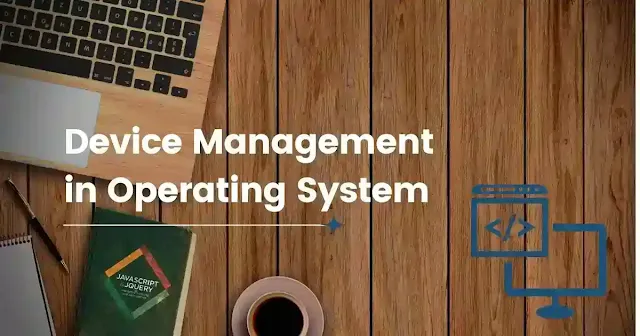Introduction:
Operating systems are the backbone of any computing device, orchestrating the interaction between hardware and software. One crucial aspect of this orchestration is device management. In essence, device management involves handling the myriad hardware components connected to a system, ensuring they operate seamlessly. In this article, we'll delve into the intricate world of device management in operating systems, exploring its types, functions, challenges, and future trends.
Types of Devices in Operating Systems:
When we talk about devices in the context of operating systems, we encompass a wide array, from keyboards and displays to disk drives and network interfaces. These devices are typically classified as input, output, and storage devices. Each type plays a distinct role in the overall functionality of the system, necessitating specialized management strategies.
What is device management in operating system?
Device Management Functions:
The core functions of device management revolve around resource allocation and deallocation. Efficient allocation ensures that each process receives the necessary resources from the devices it requires, while deallocation ensures that resources are freed up once a process completes its execution. Fair access to devices is paramount, preventing monopolization by a single process.
What is management in operating system?
Device Drivers:
Device drivers act as intermediaries between the operating system and hardware devices. They translate high-level commands from the operating system into low-level commands that the hardware can understand. The importance of well-designed device drivers cannot be overstated, as they facilitate smooth communication and cooperation between software and hardware components.
What is device management in kernel?
Interrupt Handling:
In the dynamic environment of computing, interrupts are events that require immediate attention. Operating systems manage interrupts, prioritizing them based on their significance. This ensures that critical tasks are addressed promptly, contributing to the overall responsiveness and efficiency of the system.
What are the 4 types of operating system?
- Real-time operating system (RTOS): Designed to handle real-time applications with strict timing requirements.
- Single-user, single-task operating system: Supports a single user and allows one task to be executed at a time.
- Single-user, multi-tasking operating system: Allows a single user to perform multiple tasks simultaneously.
- Multi-user operating system: Supports multiple users and allows multiple tasks to be executed concurrently.
I/O Scheduling:
Input/Output (I/O) scheduling is a vital aspect of device management, especially in systems with multiple processes competing for access to devices. Various scheduling algorithms, such as First-Come-First-Serve (FCFS) and Shortest Job Next (SJN), determine the order in which processes are granted access to devices. This helps balance system load and optimize performance.
Error Handling in Device Management:
Robust error handling mechanisms are imperative in device management to guarantee system stability and reliability. Detecting errors, whether hardware or software-related, and implementing effective error-handling strategies prevent system crashes and data corruption.
Security Measures in Device Management:
Device management also plays a crucial role in system security. Implementing access controls and authentication mechanisms ensures that only authorized processes can interact with specific devices. This safeguards sensitive information and prevents unauthorized access or manipulation.
Evolution of Device Management:
A historical perspective on device management reveals its evolution alongside advancements in hardware and software. Early operating systems had rudimentary device management, while modern systems boast sophisticated mechanisms to handle a plethora of complex devices seamlessly.
Challenges in Device Management:
Despite advancements, managing devices in operating systems poses challenges. Compatibility issues, resource contention, and the sheer diversity of devices are among the common hurdles. Nevertheless, these obstacles offer chances for creativity and enhancement.
Case Studies:
Examining real-world examples of successful device management implementations provides valuable insights. From large-scale data centers to personal computing devices, understanding how organizations effectively manage their devices offers practical lessons for optimizing system performance.
Future Trends in Device Management:
The landscape of device management is continually evolving. Emerging technologies, such as the Internet of Things (IoT) and edge computing, are reshaping how devices are managed. Predicting these trends helps system administrators prepare for the challenges and opportunities ahead.
Best Practices for Device Management:
Drawing on experiences and lessons learned, establishing best practices for device management is crucial. Guidelines for efficient resource allocation, proactive error detection, and adaptive I/O scheduling contribute to a well-managed and high-performing system.
Impact of Device Management on System Performance:
Well-managed devices have a direct impact on overall system performance. Metrics such as response time, throughput, and resource utilization offer quantifiable measures of the effectiveness of device management strategies.
Conclusion:
In conclusion, device management is a linchpin in the seamless operation of operating systems. From the early days of computing to the era of interconnected devices, its significance has only grown. Efficient device management ensures that hardware resources are optimally utilized, contributing to the overall performance and reliability of the system.
FAQs
What is the primary role of device drivers in operating systems?
Device drivers act as intermediaries, translating high-level commands from the operating system into low-level commands that hardware can understand. They facilitate communication between software and hardware components.
How does device management contribute to system security?
Device management plays a crucial role in system security by implementing access controls and authentication mechanisms. This ensures that only authorized processes can interact with specific devices, preventing unauthorized access or manipulation.
What are the common challenges in device management?
Common challenges include compatibility issues, resource contention, and the diversity of devices. These challenges provide opportunities for innovation and improvement in device management strategies.
How has device management evolved over time?
Device management has evolved alongside advancements in hardware and software. Early operating systems had rudimentary device management, while modern systems boast sophisticated mechanisms to handle a plethora of complex devices seamlessly.
Why is I/O scheduling important in device management?
I/O scheduling is crucial in device management, especially in systems with multiple processes competing for access to devices. Various scheduling algorithms determine the order in which processes are granted access, balancing system load and optimizing performance.

